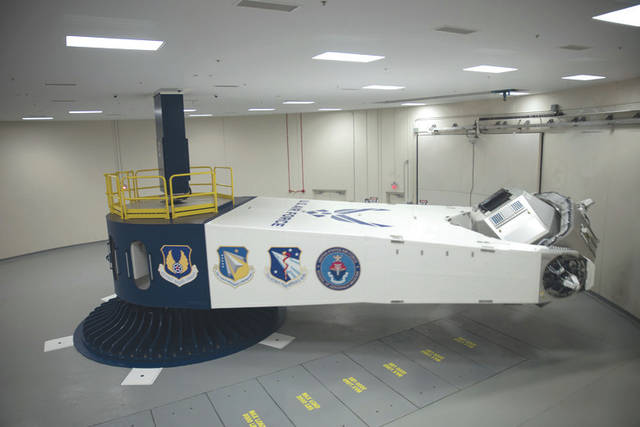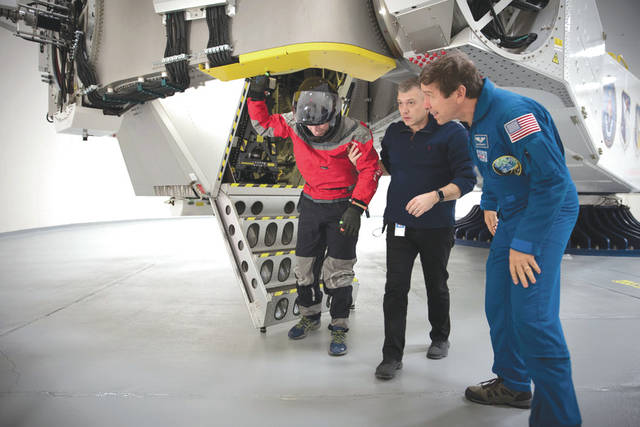

WRIGHT-PATTERSON AIR FORCE BASE — It’s not often that Wright-Patterson Air Force Base hosts astronauts testing in its facilities. In fact, it’s been since the 1960s.
But due in part to the relationship between the Air Force and NASA as well as the location and unique capabilities of the Defense Department’s only human-rated centrifuge, 10 astronauts in their royal blue flight suits walked through the doors of the Air Force Research Laboratory’s 711th Human Performance Wing at Wright-Patterson Air Force Base Nov. 1 to undergo two days of centrifuge testing.
“We are thrilled to have NASA and Boeing astronauts testing in our facilities,” said Brig. Gen. Mark Koeniger, 711HPW commander. “Our partnership brings the 711th Human Performance Wing’s unique capabilities into the Space domain using our brand new centrifuge. We designed the system to be agile and rapidly adaptable for any possible customer, and NASA was ecstatic to be our first partner outside the DOD.”
The agility of this new centrifuge rests in its interchangeable cockpits. The AFRL-NASA discussion began in August and is when engineers from both teams began working to transform the centrifuge, more commonly used for fast-jet pilot training, into a system for astronaut testing.
For aircrew training, the centrifuge allows students and USAF fast-jet aviators the capability to experience up to nine Gs, or nine times the normal force of gravity, to teach the effects of G-forces on human physiology. Also, it allows for the measure of the flyer’s ability to counteract the effects and prevent G-induced loss of consciousness.
“For pilots, the G-forces are felt through the top of the head in the z-axis,” said Fleming. “But for astronauts, the G-forces are felt mostly in the chest in the x-axis. They have to still be able to reach forward and accomplish certain tasks on their control panels.”
These tasks were part of the testing that each of the 10 astronauts had to accomplish as the centrifuge spun. They also had pre- and post-test questionnaires as well as NASA physicians, who also conducted pre- and post-medical exams to bookend their centrifuge spins.
The astronauts, nine from NASA – one, Boeing, each took a turn, literally and figuratively, and this testing marked the beginning of what could be a new era of space travel.
One of the 10 astronauts testing was Chris Ferguson, a former Navy fighter pilot, and former NASA astronaut who flew to space three times and was commander of shuttle Atlantis in 2011, the final shuttle to launch from the United States. Ferguson still wears the royal blue space suit but now, for Boeing as the first commercial astronaut. He explained that Boeing was testing in the centrifuge at the invitation of NASA.
The astronauts who participated in the testing included Ferguson, Bob Behnken, Mike Hopkins, Sunita Williams, Eric Boe, Josh Cassada, Victor Glover, Douglas Hurley and Nicole Mann. In addition, astronaut candidate Zena Cardman, who is currently going through her initial astronaut training, joined the group to provide additional data for the test.
NASA astronaut and physician Michael Barratt, who also is a Wright State University alumnus and worked with AFRL researchers for his master’s thesis, discussed the new space vehicles, the different experience of G-forces in these vehicles in comparison to a high-speed jet, and the importance of readiness.
Barratt explained that during those [earlier] programs, NASA used centrifuge training both for preparing the astronauts to feel those G loads and to work and learn how to operate under them, but also to inform design, and cockpit strategies and operations.
“Who knows where this will lead,” said Ferguson, “but I think it’s a pretty darn good start.”





